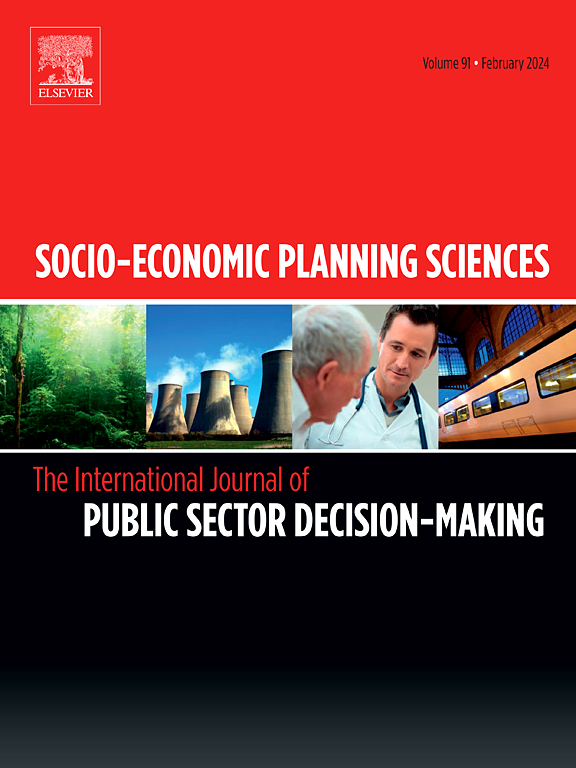Integrated sustainability perspective to interconnect circular economy, environmental development, and social status: designation of sustainable development spillovers
IF 5.4
2区 经济学
Q1 ECONOMICS
引用次数: 0
Abstract
The European Union (EU) is the most successful region globally regarding sustainable development but all its Sustainable Development Goals (SDGs) have still low scores and high challenges, which signal the non-optimal spillovers from the other regions. This issue further complicates Europe's policy-making in its international relationships, especially with the greatest global economic powers like the United States (US) and China. To address the issues, this research aims to measure the spillovers of sustainable development between the EU, US, and China. To this end, it estimates their sustainability elasticities within 1973–2020, using the econometric technique of the SEY model, to examine the novel perspective of “Integrated Sustainability”. The results show that the sustainability elasticities are mainly positive, confirming the synergistic spillover effects of sustainability among the pillars of sustainable development. This finding adds the sustainability spillovers as the 4th pillar of sustainable development to the three traditional pillars including social status, environment development, and circular economy. In addition, the spillovers show a symmetric format among the sample countries, implying a balanced relationship with the other countries. According to this finding, policy-makers should strengthen international relationships with other countries and regions, including both Western and Eastern powers, by improving peaceful connections. In this policy-making, they should build a balanced regional and economic connection for an integrated world with a multilateral and flow-based governance system instead of unilateral and local-based governance.
循环经济、环境发展和社会地位相互关联的综合可持续性视角:可持续发展溢出效应的界定
欧盟是全球可持续发展最成功的地区,但其所有的可持续发展目标(sdg)仍然得分低,挑战大,这表明其他地区的非最优溢出效应。这个问题进一步使欧洲在国际关系中的决策复杂化,尤其是与美国和中国等全球最大的经济大国的关系。为了解决这些问题,本研究旨在衡量欧盟、美国和中国之间可持续发展的溢出效应。为此,本文利用SEY模型的计量经济技术,估计了1973-2020年的可持续性弹性,以检验“综合可持续性”的新视角。结果表明,可持续性弹性主要为正,证实了可持续性在可持续发展支柱之间的协同溢出效应。这一发现将可持续性溢出作为可持续发展的第四大支柱,增加到传统的社会地位、环境发展和循环经济三大支柱之上。此外,样本国家之间的溢出效应呈现对称形式,这意味着与其他国家之间的关系是平衡的。根据这一发现,政策制定者应该通过改善和平联系来加强与其他国家和地区的国际关系,包括西方和东方大国。在这一决策中,他们应该建立一个平衡的区域和经济联系,以多边和流动为基础的治理体系,而不是单边和地方治理。
本文章由计算机程序翻译,如有差异,请以英文原文为准。
求助全文
约1分钟内获得全文
求助全文
来源期刊

Socio-economic Planning Sciences
OPERATIONS RESEARCH & MANAGEMENT SCIENCE-
CiteScore
9.40
自引率
13.10%
发文量
294
审稿时长
58 days
期刊介绍:
Studies directed toward the more effective utilization of existing resources, e.g. mathematical programming models of health care delivery systems with relevance to more effective program design; systems analysis of fire outbreaks and its relevance to the location of fire stations; statistical analysis of the efficiency of a developing country economy or industry.
Studies relating to the interaction of various segments of society and technology, e.g. the effects of government health policies on the utilization and design of hospital facilities; the relationship between housing density and the demands on public transportation or other service facilities: patterns and implications of urban development and air or water pollution.
Studies devoted to the anticipations of and response to future needs for social, health and other human services, e.g. the relationship between industrial growth and the development of educational resources in affected areas; investigation of future demands for material and child health resources in a developing country; design of effective recycling in an urban setting.
 求助内容:
求助内容: 应助结果提醒方式:
应助结果提醒方式:


